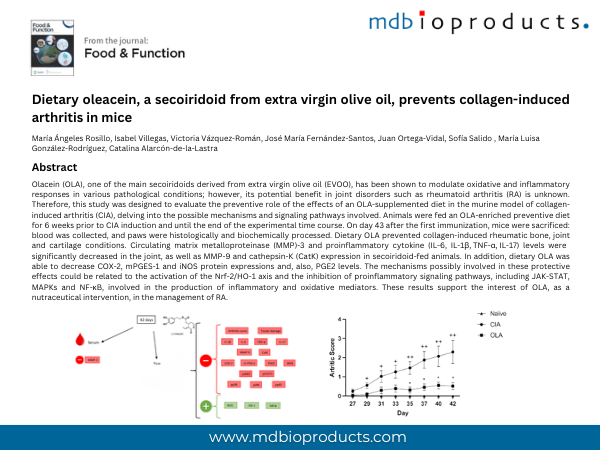
Featured Publication in Focus: Dietary oleacein, a secoiridoid from extra virgin olive oil, prevents collagen-induced arthritis in mice
Feb 13 , 2024
Authors:
María Ángeles Rosillo, Isabel Villegas, Victoria Vásquez-Román, Josè María Fernández-Santos, Juan Ortega-Vidal, Sofía Salido, María Luisa González-Rodríguez and Catalina Alarcón-de-la-Lastra
Universidad de Sevilla, 41012 Seville, Spain
- Department of Pharmacology
- Instituto de Biomedicina de Sevilla
- Department of Normal and Pathological Cytology and Histology
- Department of Inorganic and Organic Chemistry
- Department of Pharmaceutical Technology
Royal Society of Chemistry. Food & Function. 11 December 2023
----------------------
Products referenced:
Catalogue Number: 804001-sol
Collagen Type II, Bovine, Immunization Grade, Soluble, 2 mg/mL
----------------------
ABSTRACT
Olacein (OLA), one of the main secoiridoids derived from extra virgin olive oil (EVOO), has been shown to modulate oxidative and inflammatory responses in various pathological conditions; however, its potential benefit in joint disorders such as rheumatoid arthritis (RA) is unknown. Therefore, this study was designed to evaluate the preventive role of the effects of an OLA-supplemented diet in the murine model of collagen-induced arthritis (CIA), delving into the possible mechanisms and signaling pathways involved. Animals were fed an OLA-enriched preventive diet for 6 weeks prior to CIA induction and until the end of the experimental time course. On day 43 after the first immunization, mice were sacrificed: blood was collected, and paws were histologically and biochemically processed. Dietary OLA prevented collagen-induced rheumatic bone, joint and cartilage conditions. Circulating matrix metalloproteinase (MMP)-3 and proinflammatory cytokine (IL-6, IL-1β, TNF-α, IL-17) levels were significantly decreased in the joint, as well as MMP-9 and cathepsin-K (CatK) expression in secoiridoid-fed animals. In addition, dietary OLA was able to decrease COX-2, mPGES-1 and iNOS protein expressions and, also, PGE2 levels. The mechanisms possibly involved in these protective effects could be related to the activation of the Nrf-2/HO-1 axis and the inhibition of proinflammatory signaling pathways, including JAK-STAT, MAPKs and NF-κB, involved in the production of inflammatory and oxidative mediators. These results support the interest of OLA, as a nutraceutical intervention, in the management of RA.
To continue reading and to download the publication:
